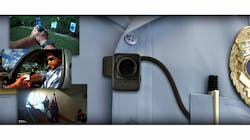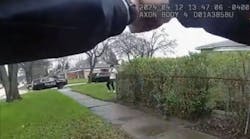Few things say, “That defendant is lying,” like a high quality video that shows the exact opposite of what the defendant just testified to. Convictions can be, and have been, won on such counter-evidence. Few things exonerate a law enforcement professional from a false accusation of unnecessary force better than a high quality video that demonstrates how the officer (often) didn’t even use as much force as could have been justified. Such is the power of video from body-warm cameras. That said, the value of the video is only as good as the video captured and the saturation of us. Let’s be realistic: If it’s not on… not only on your person but also ON as in recording… when you need it, it’s not worth having.
So, the first rule of body-warn cameras: Get a decent quality system. Don’t get the cheapest thing you can find just so your agency can put out a PR piece bragging about having “body-cams.” The second rule of body-warn cameras: WEAR THEM and USE THEM. The video can’t save your case--or your career--if it’s not recording when you most need it to be. Unfortunately, in law enforcement, we simply never know when that exact moment is going to arrive.
I recently got my hands on Digital Ally's® First Vu HD body camera system. Available either as a single (roughly) rectangular unit or as a two-piece system that includes the camera head and the Digital Video Recorder (DVR) as a separate piece, the First Vu was impressive fresh out of the box simply because of the features and options available from this company.
Let’s talk for a minute about the unit and some of the desirable features (and why) for law enforcement.
It is small, rugged and lightweight. Size matters. Don’t ever let anyone tell you any different. In this case, smaller is better as long as we don’t sacrifice durability and performance. The First Vu system seems to have found a good balance as this compact unit of two components can provide high quality video as indicated below.
It can automatically start recording simultaneously with an In-Car Video System (requires VuLink). If you are combining your body-worn system(s) with in-car video, being able to sync recordings and time stamps can be invaluable. Note that the First Vu body-worn systm doesn’t require a Digital Ally® in-car system but it DOES require their VuLink product.
The user-replaceable and rechargeable battery can last a full shift and then some. Thankfully, none of us record every moment of a full shift. (Bathroom breaks would get a bit embarrassing if we did.) So having recording capability for half your shift or more should be more than sufficient. With over two days of power in stand-by mode, one battery should easily last you a full shift, even with unexpected overtime, court, etc. thrown in. Add to that the fact that the battery is user-replaceable and you should never have a dead battery in your body-cam.
It can record in high quality SD or 720p HD H.264 Video depending on which resolution option you choose. Given that a great many commercially available digital video cameras sold for recording life’s memorable moments don’t even have the option 1280x720 HD H.264 video, this ought to be more than sufficient for your agency needs.
You can control (well, administrators can) whether the audio is always on or off. While I personally wouldn’t always want every word recorded, unless you have another audio recording system to mate with this, I’d strongly recommend that you have the audio on and kept on. Yes, that sometimes means we need to filter what we say while we’re angry.
With 25-54 Hrs. of record time (depending on memory usage based on quality setting), you have more than enough recording storage to cover multiple shifts or extra-long emergency deployments. See above for battery life. You have more record time than you do energy time (for the most part).
The 130° field of view allows you to capture faces plus important events. When I was once shown what the camera caught but I didn’t see, it was amazing. When anyone talks about the evidentiary value of video captured by a body-worn camera, they quite often don’t mention this particular “feature.” The camera sees without tunnel vision, within the confines of its design. That means that it often sees things we never consciously registered. After the fact, during debriefings, after action reports, training analysis, etc., the video is an awesome tool for picking up what we didn’t “in real life” or “in real time.”
It has enhanced low-light sensitivity (.08 Lux for night recording). If the camera can “see” with such sensitivity, it may well (again) see things we don’t. This sensitivity to light for recording with using (and therefore charging us for) infrared devices or other night-vision enhancements, adds to the long term potential value of the camera and any video captured.
Good water resistance ratings measured beyond typical standard. Given that we law enforcement professionals have to work in rain, snow, sleet, hail, hurricanes, tornadoes, etc. this is a necessary feature. While I didn’t saturate or sink my test unit, I didn’t see any issues or challenges with rain either.
The extendable breakaway Cable is important for both officer safety & comfort of wear. What mattered to me most about this was the “breakaway” part. Way back in the academy I was taught that having anything tied to my body, most especially if it went around my neck (like a tie), was a potential noose or come-along for someone to use against me. If the camera system had a fixed cable connection (as opposed to breakaway) then I’d be concerned about it from the officer safety standpoint. WITH the breakaway cable, no one can use it to pull you around like you’re on a leash.
Up to 60-Sec. Pre-Event Recording captures audio &/or video of events that occurred before pressing record. Pay attention to this one. Read it again. When you press record the camera/unit already has the past sixty seconds captured. That means it’s recording on a dump-loop. It captures and drops video almost constantly. (While this may not be a correct technical description of what’s being done, it’s an acceptable operational description.) That means that you can’t curse and act unprofessionally one moment, then hit press and immediately start being Mr. Professional while intending to use the video to prove your courteous behavior.
Easy one-button operation follows the K.I.S.S. principle, because easier is faster and simpler. ‘Nuff said.
Saves Date/Time Stamp & Marks (Marks track the location of important events during a recording). This can be an awesome capability to have when you’re looking for precipitating events that you want to cite in your report(s), briefs, etc.
The covert mode deactivates LEDs on the camera (vibrating confirmations and DVR LEDs remain on). Let’s be honest: There are times we don’t want people to know that we’re recording everything and there are certainly times we don’t want little flashing lights to give us away. Being able to “go covert” is a good thing.
It records standard use AVI videos which are easily downloaded via a USB port. Because few things suck worse than having a body-worn camera system that records proprietary videos you have to have special players for in court. The same USB port allows for software upgrades as necessary.
Coming Soon: Hat or glasses-mounted bullet camera, Live Streaming Interface, Control / Management Mobile App and other options
While this bullet camera is shown on the Digital Ally® website as “coming soon,” the press release information we’ve received shows it as available. The bullet camera allows for mounting the camera on the frame of eyeglasses / sunglasses, hats, etc. I like the idea of mounting the camera on the arm of a pair of eyeglasses or sunglasses because the video captured gives a more realistic image of what the officer sees. The video is captured from the same level as the eyes and is always facing in the direction that the officer’s face is facing. With a body-worn camera mounted on the chest, the camera could be pointed to the front while the head is turned to the side and something completely off camera might be necessary to the officer’s case or defense.
The test and evaluation unit I received performed as advertised and wasn’t complicated. Once charged, the unit was easy to wear, to record with, to download from, etc. I did wear on my raincoat for about two hours during inclement weather one afternoon and, after wiping dry with a cloth towel, could find no challenges or functional impairments as a result.
I barely noticed having it on and will be recommending it to my agency when they’re in the market for body-worn cameras.
Stay safe!



